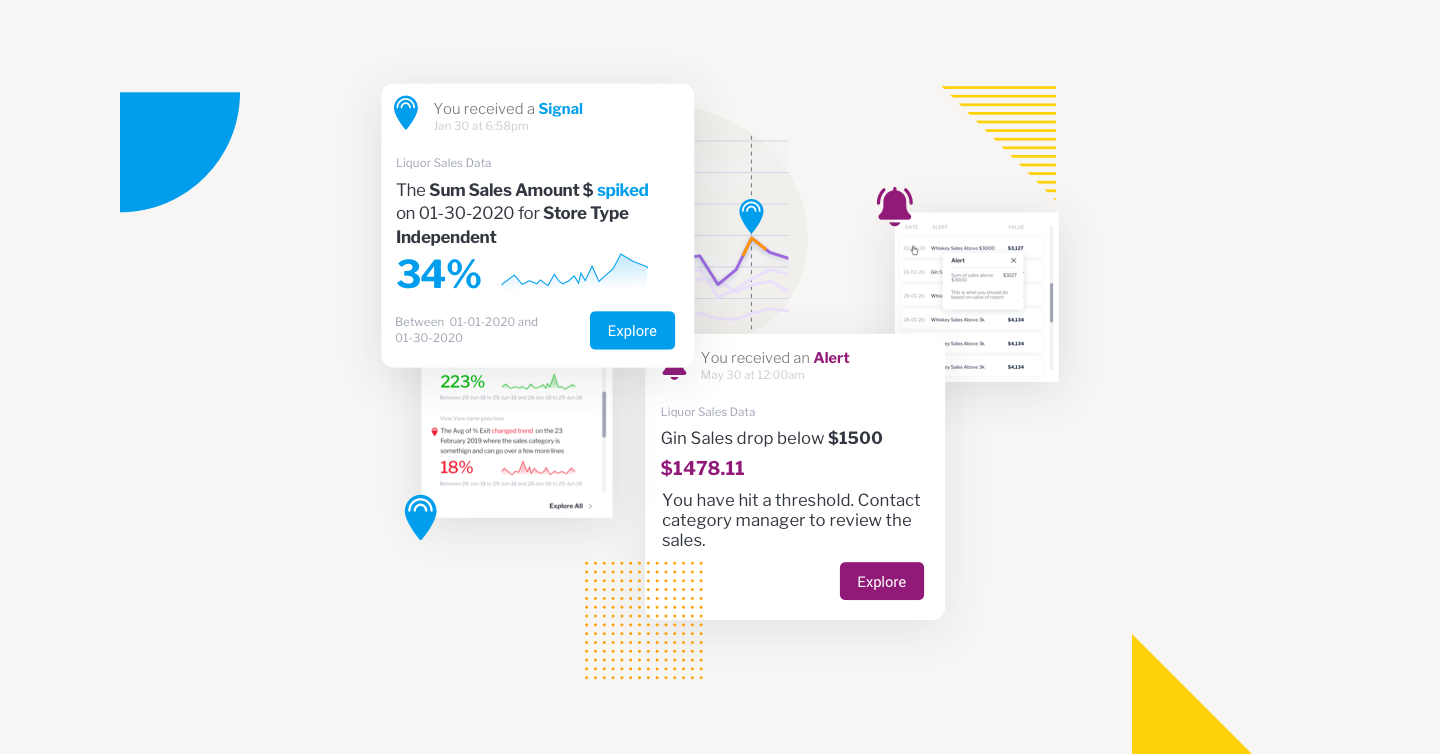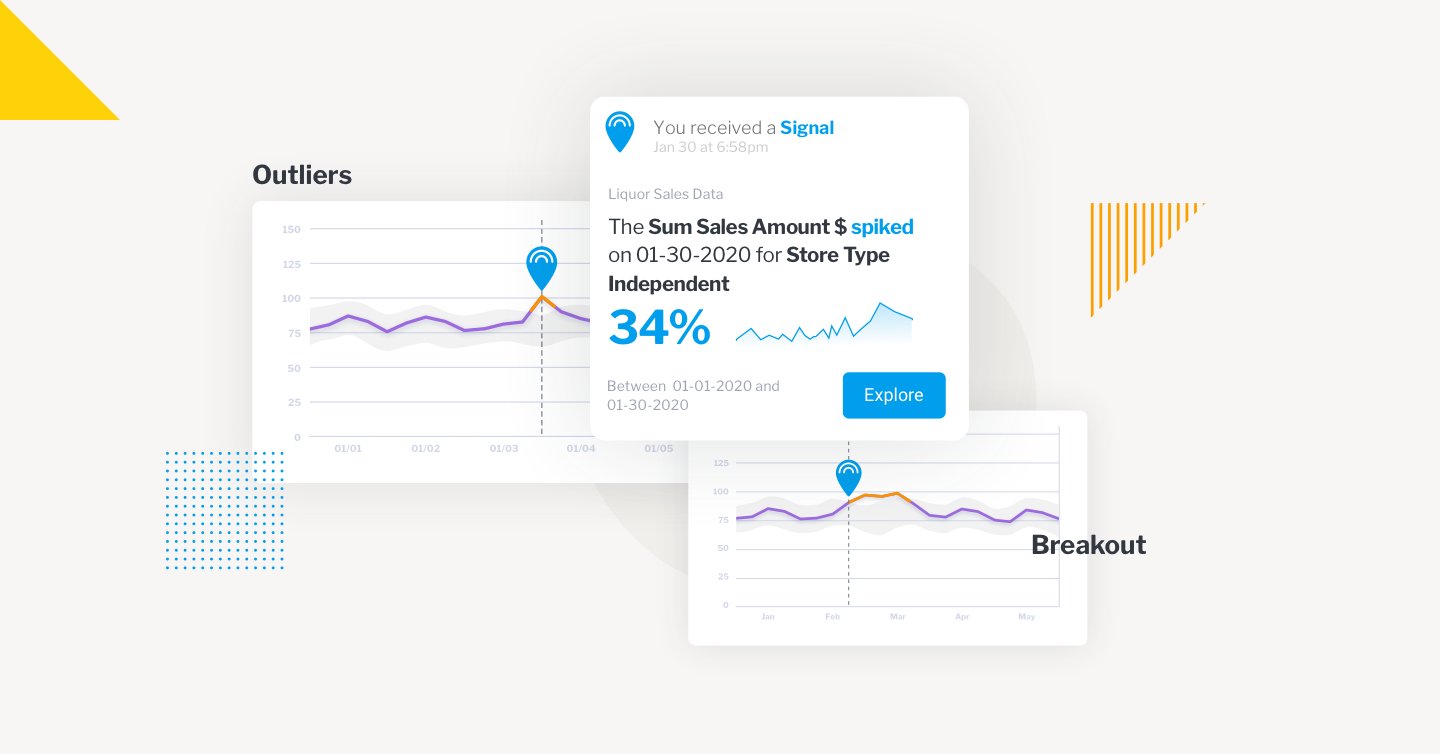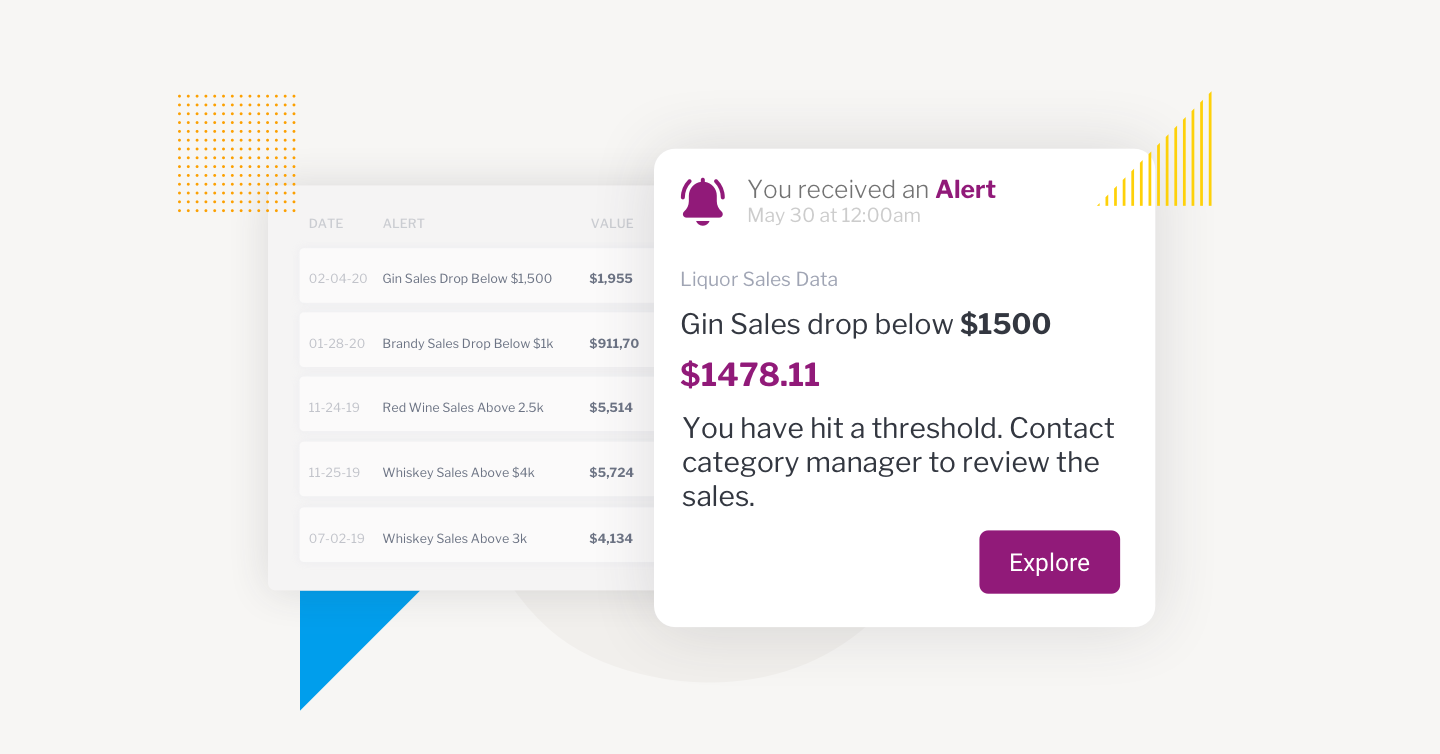
What is Automated Business Monitoring? Everything You Should Know
Today, organizations need to know what data they have, what it means, when it changes, and how it delivers value faster than ever before.
Modern businesses have a problem, though – a continuously growing mountain of data, made up of many different operational processes and performance metrics, which users must proactively monitor to ensure business goals are met, and insights are deciphered.
Embedded dashboards are one way for your users to keep track of key information while using your application. But creating, exploring, and monitoring the data within them constantly is a manual task, one that takes a lot of time and effort to discover everything.
Relying solely on this sort of manual monitoring typically means your users could miss potential changes or trends in their reports – consequently, your team could face lost opportunities, high costs, and customer dissatisfaction with your product experience.
Thankfully, the last few years have seen a number of business intelligence (BI) solutions help lessen the time and effort it takes for regular users to both monitor and analyze key metrics and find relevant insights with automated business monitoring (ABM), the ability to automate the analysis of your information (data discovery) at scale – and very fast.
There’s a lot of talk about the differences between what regular dashboards do and what today’s automated business monitoring systems can provide, so we break down the key points you need to know about ABM here so you can prepare for its must-have benefits.
What does automated business monitoring (ABM) mean?
Automated business monitoring, also called automated analytics or automated reporting, is the ability of your analytics platform to auto-detect relevant insights – anomalies, trends, patterns – and deliver them to your business users in real-time, without users having to manually explore their data to find the answers they need. An analytics platform with automated business monitoring uses algorithms to auto-analyze datasets to search for notable changes in data. It then generates alerts at fixed intervals or triggers (thresholds) and delivers the findings to each user, ready-made. These processes serve to extend and not replace your traditional business intelligence tools (dashboards and reports), and overall, they provide a richer and more personalized analytics experience for your end-users from start to finish. Any BI solution with automated business monitoring as a capability provides significantly more avenues to inform your users of the exact details behind every alert:- What’s happened in the data (is it a deviation, pattern, trigger, or trend?)
- Where did it happen (which dataset, area of business, country, region?)
- When it’s occurred (exact time and date)
- How performance is affected (is it an opportunity or an emergent problem to fix?)
How does automated business monitoring work?
There’s much talk of automation in the BI space, but how does it fit with business monitoring? ABM is achieved through the use of emerging technologies like machine learning (ML) algorithms, natural language generation (NLG), and specialized statistics. Combined together, these powerful features enable an analytics platform to continuously monitor operational data and analyze factors that align with your desired business outcomes. This type of advanced analytics leans toward time-series-based analysis and focuses on finding critical changes in categories like outliers (spikes and drops), volatility, step changes, average and total, and trend direction. If you have an app with automated business monitoring as an embedded function, you can configure these advanced algorithms to simultaneously monitor and track far more metrics than what a standard dashboard can accomplish and across more dimensions.
Activating these features is streamlined where it’s available – generally, you just need to connect existing data sources to begin automatically generating a baseline of behavior. The system will then begin to establish monitoring and tracking functions. The best ABM solutions then allow you to set up and customize parameters in more detail to ensure the results for your users are much more targeted and relevant to their needs.
Automated analysis is also dynamic when it comes to separating signals from noise. Yellowfin Signals, for instance, is an ABM tool native to Yellowfin that uses complex ranking algorithms in the background to detect the most relevant deviations from your baseline; it then ranks data for each individual user based on the user’s previous system usage and exploration habits.
Once Signals has found a critical change, it will deliver these alerts to your users. The order in which alerts are shown is then influenced by each user’s interaction and exploration activity with these types of Signals; if they examined alerts around sales in one region, Signals will learn over time to show more insights related to that area first.
By leveraging such powerful machine learning capabilities, your customers only get the most relevant and personalized insights as alerts.
Read more: How businesses use automated business monitoring
Yellowfin Signals - A brief explainer
Signals is a ABM tool native to the Yellowfin embedded analytics suite that enables automated data discovery, tracking and alerting of your most critical business data. Signals uses automated business monitoring technology to enable continuous monitoring and analyzing of data-sets to guide users toward the most statistically relevant changes, or even interesting, hidden patterns in data. Signals is an exclusive feature of Yellowfin - you can learn more about the types of changes in data it automatically monitors on your behalf in our beginner's guide, What is Yellowfin Signals?What is automated business monitoring used for?
One pain-point we hear from customers is their end-users, while having dashboards and reports available and embedded within their line-of-business applications, would prefer to have their analytics proactively notify them of changes to data and potential insights. It’s a sentiment that many external studies, such as Eckerson Group’s report, ‘Business Monitoring Systems: Using Machine Learning to Analyze Business Metrics’, have increasingly found accurate. In the paper, Eckerson found that more companies today are beginning to adopt and use business monitoring systems with automation capabilities for use-cases, including:-
- Detecting patterns of fraud
-
- Managing ongoing cloud computing and digital transformation costs
-
- Monitoring performance of payment gateways, partner APIs and channel partners
-
- Sending auto-notifications when users encounter technical issues in their application
-
- Tracking changes in customer behavior across product segments or channels
Automated business monitoring: Top 5 benefits
How does having the ability to automate monitoring/reporting help businesses today? Here are key ways automation helps elevate your embedded analytics and BI platform:1. Lower costs and improved ROI
On top of your regular tracking of performance via dashboards, using automated business monitoring tools like Signals helps you proactively detect issues. This allows your users to prevent or resolve them before they become potential problems, reducing risk and unnecessary expenditure. For example, a Yellowfin customer in Japan, offering beauty and healthcare products, faced stock shortages due to mismanagement of inventory. They often missed items with minimal stocks and misjudged the timing for placing orders, resulting in significant losses. By leveraging Yellowfin Signals’ ABM capabilities, they were able to detect stock issues in advance and take timely action. This proactive approach reduced their annual losses of 50 million yen from stockouts to nearly zero this fiscal year. Enabling users to receive fast, proactive alerts when problems arise can greatly enhance customer satisfaction and drive business growth. See our KYOWA case study for more information.Cost savings
Effective business activity monitoring also helps identify inefficiencies, reduce risks, and avoid unnecessary expenditures, contributing to significant cost savings.Increased ROI
By using automated business monitoring processes, businesses can significantly improve their operational efficiency. With these capabilities, business owners can identify new and better opportunities before competitors and make strategies to increase their ROI.2. Increased agility
The value of being able to respond to changes, deviations, trends or correlations in our business data faster thanks to automatic monitoring and auto-generated insights cannot be understated. For example, a liquor distributor used automated analytics via Yellowfin Signals and detected an outlier in sales for whiskey, 300% above the moving average. This helped end-users correlate the anomaly with other relevant changes, specifically a spike in sales for Johnnie Walker Premium. There, they discovered a correlation between an external TV promotional campaign for its premium whiskeys and the sales spike. While this sort of insight is possible to manually discover via regular dashboards and reports, the addition of automated analysis via Yellowfin Signals ensured faster reaction and detection.
3. Focus on other priorities
With the time savings found in having automated business monitoring as a capability, ABM augments the capabilities of your BI users (whether they’re regular business users or data analysts) and increases their effectiveness and productivity.4. Relevant, personalized insights
Automated analytics makes it possible for your application’s embedded analytics to generate more timely, accurate and relevant alerts. Getting notified about changes in your data after the fact provides little to no value, but with real-time notifications, that is no longer a problem. The intelligent design offered by having machine learning algorithms run your monitoring means you can create a behavioral baseline for your most important metrics, improve accuracy over time, and create alerts aligning with what users consider relevant. This ensures insights are delivered efficiently, saving time and effort in data discovery.5. Faster, easier data analysis
Creating data visualizations or configuring logic and time-series databases beforehand is not always possible for every type of user – even those that have embedded analytics at their fingertips. With ABM, this is not required; the system auto-generates a baseline of behavior for countless metric combinations and proceeds to identify and alert users of any critical changes detected over time. By being able to automatically provide real-time notifications of changes, correlations and analysis for your users without human input, they ultimately have more opportunities to quickly learn of new insights and act. Because ABM is intertwined with cloud-based services and functions, they’re faster and scalable than legacy monitoring solutions, too. Read more: 5 key business benefits of automated business monitoringWhat is the importance of business monitoring?
Automated business monitoring impacts a business's financial health and success in the field. Now let's understand this in detail with the following points mentioned below:Proactive decision-making
Business monitoring enables organizations to detect anomalies, trends, and performance issues in real time. This proactive approach ensures timely decision-making and helps prevent potential problems before they escalate.Enhanced efficiency
Automated business monitoring reduces the manual effort required to analyze data, allowing teams to focus on strategic priorities and boosting overall productivity.Improved customer satisfaction
By identifying and addressing issues quickly, businesses can enhance customer experiences, minimize disruptions, and build stronger relationships.Data-driven insights
Continuous business process monitoring provides actionable insights, empowering businesses to adapt quickly to market changes, capitalize on opportunities, and maintain a competitive edge.Why should I get started with automated monitoring and automated analytics?
Ultimately, ABM has changed how, where and why users interact with analytics by switching the focus from empowering analysts to empowering regular users. While the tech is still evolving, automated business monitoring systems are clearly poised to play an increasingly important role in both our choice and usage of analytics platforms. Having automated analytics as part of your platform can save your team time and money in auto-tracking and analyzing data in a timely, efficient manner so your analysts can focus on higher priorities. Most importantly, it can help your users address issues before they escalate into problems faster, and find new insights they might not have previously. Understandably, automation is not often the first business driver organizations consider when searching for a modern analytics platform, as it’s considered an advanced subject. One thing all product managers can do first when considering how to elevate your application’s BI capability is to be informed about just how streamlined ABM is becoming – and how accessible it is today in leading embedded analytics solutions like Yellowfin.Frequenty Asked Questions (FAQs)
What does BAM mean in business?
Business Activity Monitoring (BAM) refers to tracking real-time business processes and activities using business monitoring systems and tools. It helps organizations optimize operations and gain actionable insights to improve efficiency and decision-making. Automated business monitoring is an extension of these solutions, providing automatic alerting, analysis and findings to users of analytics tools which feature ABM, such as Yellowfin.What are the four methods of monitoring?
The four methods of monitoring include manual observation, business activity monitoring tools, automated business monitoring, and business process monitoring systems. Each method offers unique benefits for effectively tracking and analyzing business operations.What are the risks of automated controls?
Automated controls may face risks such as system errors, configuration issues, or reliance on outdated business monitoring systems. Proper implementation of business activity monitoring tools mitigates these risks while ensuring reliable and efficient operations.What is compliance monitoring in business?
Business compliance monitoring involves using business monitoring systems to ensure processes, policies, and operations adhere to regulations and standards. Business activity monitoring tools help identify non-compliance issues, minimize risks, and maintain organizational integrity effectively.What is the purpose of business activity monitoring?
Business activity monitoring aims to provide real-time insights into critical business operations, identify potential issues, and enhance efficiency. Automated business monitoring tools streamline processes and improve decision-making across various business functions.Conclusion
In conclusion, automated business monitoring (ABM) is significantly transforming the way organizations handle data. ABM can be done by providing real-time, proactive insights that drive smarter decisions. With its ability to detect trends, anomalies, and critical changes automatically, ABM reduces the manual effort involved in data analysis and enhances efficiency, cost savings, and customer satisfaction. By integrating ABM into your business intelligence platform, you can empower your team to act quickly on valuable insights, improve performance, and stay ahead of the competition. As this technology continues to evolve, it’s clear that ABM will be a key driver of business success moving forward.Download Your Free Whitepaper on Automated Business Monitoring
Learn exactly how automated analytics platforms like Yellowfin Signals are helping organizations improve their product experience in Business Monitoring Systems: Using Machine Learning to Analyze Business Metrics.